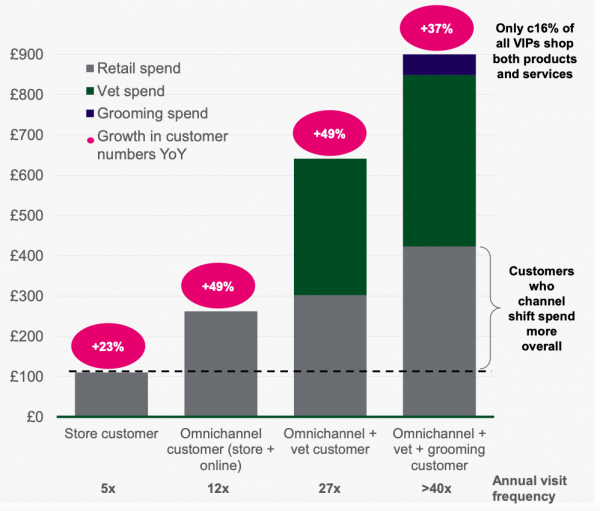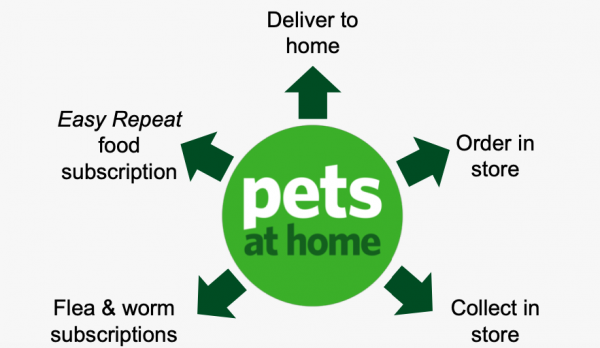Pets at Home is bucking the trend for retailers to struggle and even go bust. They have just posted forecast-beating first half results, with a near 19% growth in underlying pre-tax profit and an impressive ninth consecutive quarter of like-for-like retail sales, up 7.7%.
Here we look at how Pets at Home has revtalised its retail proposition to survive and thrive in todays’ challenging times (1).
1. Re-define your market in benefit terms
The first and most fundamental thing Pets at Home did under CEO Peter Pritchard was to re-define the market they were competing in. Rather than being in pet product retailing, they now see themselves a provider of pet care. As they say on their website,
‘We are the UK’s leading pet care business, providing pet owners with everything they need to be able to look after their pet.’
2. Stretch strategically
This new market definition led to a stretch from selling food, toys and bedding into providing pet services. Current services include grooming, through the Groom Room offer, and the UK’s largest small animal vet services group, with Vets 4 Pets practices in stores and standalone locations.
Lots of brands talk about stretching beyond products to create a ‘brand experience’, but often do this in a half-hearted way. At Pets at Home the stretch has been fully followed through. Over time the vision is to make the stores a community hub for pet owners.
Major acquisitions have been made on the vet practice side. 460,000 pets were groomed in the first half of the year! Services now account for 35% of sales, with a long-term target to increase this to 50%. New opportunities are being explored, including a strategic partnership with Tailster, al eadingonline marketplace for pet walking, sitting and boarding.

3. Sell more stuff
Another smart thing about Pets for Home’s brand expansion is how it helps the company sell more stuff (SMS) in its core business. Forget about possible brand image ‘halo’ benefits often quoted as a reason for stretching a brand. The brand strategy used by Pets at Home has business model benefits that hit the bottom line. The new services drive customer penetration, and those customers who use the services become more involved with the brand and spend more on core retail (far right column in graph below).

4. Fix the value proposition
Its all well and good offering new services. But big retail brands like Tesco and Sainsbury’s have suffered in the past few years by allowing lower priced competitors to create a ‘price gap’ that undermines their value propositions. Pets for Home seem to be avoiding this problem with a three-part strategy:
- Ensure ‘acceptable’ price gap (c. 5%): on comparable products vs. pureplay online retailers
- Around the same price: on the most important products to customers
- 3% cheaper: for customers who opt into ‘Easy Repeat’ subscription and delivery service
This strategy means that Pet for Home’s price position vs the lowest price competitor has remained stable for over 12 months. As the brand enhances its service offer, this means that the value proposition should be getting stronger: more service, same price difference
5. Add value with omnichannel
‘Omnichannel’ is a hot topic but its pratical examples of brands really using it to add value are not that easy to find. Pets for Home is a good example of using omnichannel in this way:
- Creating convenient online services that make life easier for customer, and create new revenue streams, such as a subscription service for flea and worm solutions
- Opportunity to oder online and pick up in store…
- … or browse in store and order for home delivery
This seems to be seamless and also focused on providing relevant added value for customers, rather than using technology for technology’s sake which sometimes seems to be the case.

6. Working smarter, not harder
Digging deeper into the Pets at Home Investor presentation, I found an interesting aspect of the revitalisation that didn’t make the new headlines: revenue per store colleague hour had increased +11% . This was achieved not by working people harder (store colleagues actually worked 6% less hours) but rather by working smarter to reduce tasks and maximise time with customers. This should in turn make the job more interesting, increase customer satisfaction and help sell more stuff.
7.Harness the power of data
Data and AI is another headline-grabbing topic. But many companies seem to be drowning in data and struggling to know what to do with it. Pets at Home do a good job with data and this reflects a clear strategy about how to use it: to enhance the pet owning experience.
For example, The Puppy Club has >200,000 current puppy members, which is an impressive 20% of the UK puppy population. Again, this approach helps SMS, with club members spending 21% more than non-members. There are now 160,000 ‘graduates’ of the club, and spend uplift continues in to adulthood.
In conclusion, Pets at Home shows the power of defining your market in benefit not product terms, and then using this as the springboard to stretch strategically in a way that created new revenue streams and helps sell more stuff in your core business.
And next time Tibo (below) needs a groom, I’ll have to try out Pets at Home’s Groom Room service!

Sources
1. https://investors.petsathome.com/media/kchdrflq/fy20-interims-presentation-vfinal.pdf
